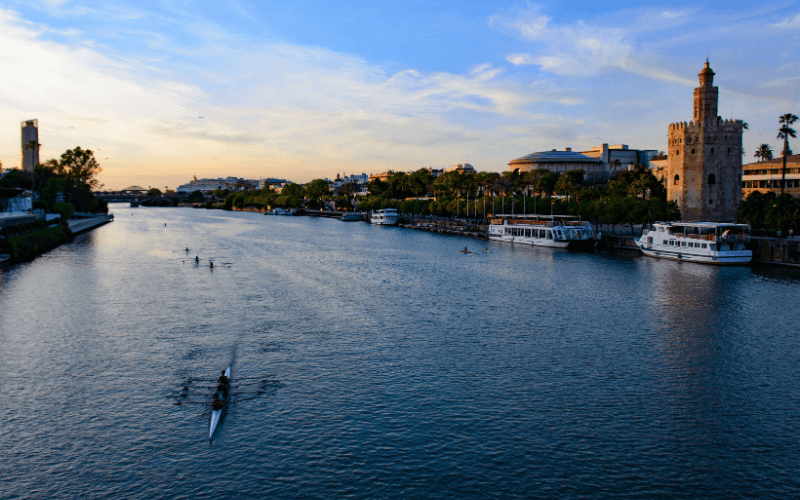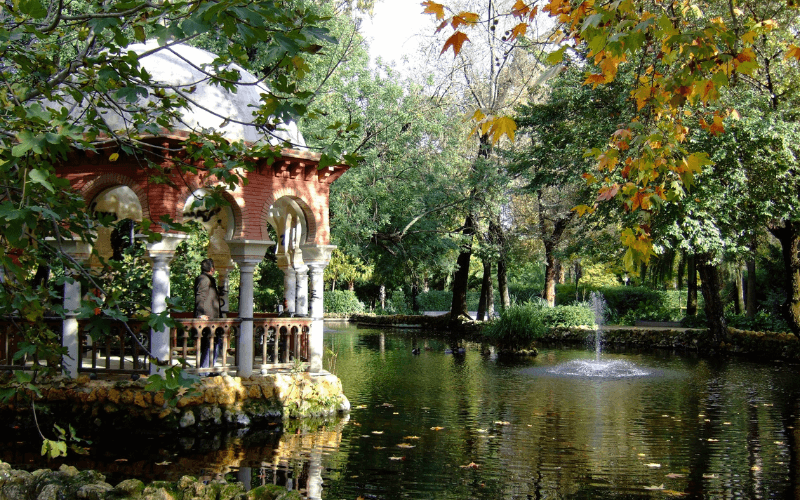
Spotlight On Spain: Seville
Expat Tips
Published: 11 July 2023 19:28 CET
Updated: 03 April 2025 19:28 CET
Seville, the capital city of Andalusia, effortlessly blends rich history with vibrant modernity, captivating residents and visitors alike.
Nestled along the Guadalquivir River, it exudes an ancient aura, with its UNESCO World Heritage Site historic centre and narrow streets brimming with tales of centuries past. The city's warm Mediterranean climate invites exploration, while its diverse neighbourhoods, from bohemian Alameda de Hércules to upscale El Arenal, offer something for everyone.
Seville's culinary scene is a gastronomic paradise, and its festivals like Semana Santa and Feria de Abril showcase its unwavering commitment to tradition. Embracing a slower pace of life, Seville fosters a strong sense of community and warmly welcomes visitors from around the world.
In this article, we will explore Seville's diverse population, favourable climate, renowned universities, and must-visit attractions that make it an irresistible destination. Join us on a journey to uncover the hidden gems and cherished landmarks that make Seville a truly unforgettable experience.
Population of Seville by Nationality
As of July 1, 2022, the resident population in Seville amounts to 1,963,000 individuals. Among them, 86,902 are of foreign origin. Over the past five years, according to data from the INE, the foreign population residing in the province of Seville has experienced a significant increase of 26.3%, equivalent to 22,905 additional individuals.
In July 2016, the number of foreign residents in the province of Seville was 63,997. By July 2022, this figure had risen to 86,902, reflecting substantial growth. Importantly, these increases in the foreign population do not impact the overall figures of the provincial population.
Regarding the migratory balance, which accounts for the difference between people migrating out and immigrants arriving, Seville recorded a positive balance of 4,623 individuals in 2022. This number represents a significant increase compared to the balance of 1,113 individuals registered in 2021.
According to data for January 2022 from the Institute of National Statistics (INE), Seville has a large foreign population of 80,150 inhabitants.
Of these the largest population are those from Morocco with 10,843. This is followed by those from Romania (8,015), China (5,551) and Colombia (4,814).
Other notable foreign residents are Italians (2,797) British (2,317), French (1,748) and Germans (867).

Weather and climate
Seville is known for its Mediterranean climate, characterised by hot, dry summers and mild winters.
Weather: Seville is tucked away in what is sometimes referred to as the "Iberian oven" because of the hot air that blows in from North Africa. This makes it an appealing destination for visitors all year round.
- Spring (March to May): Spring in Seville is still warm, with day time average temperatures of 20 °C (68 °F) in March, climbing to 26 °C (79 °F) in May.
Numerous gardens and parks of the city are blooming and the gentle scent of jasmine and rose fill the air.
- Summer (June to August): Seville is the hottest city in Spain and the warmest city in Continental Europe, with average temperatures ranging from 32°C (89°F) in June to 36°C (96°F) in July and August.
With such high temperatures locals tend to head to the coastal regions to escape the extreme heat, and visitors are advised to venture inside during the midday heat. Luckily, there are many beautiful attractions to visit like the Cathedral and Alcazar, both brilliant options to escape the sun.
- Autumn (September to November): Autumn in Seville is still warm, with average temperatures ranging from 31°C (87°F) in September, dropping to 20°C (68°F) in November.
Autumn is a great time to visit Seville as the temperature remains pleasant, but if visiting in October or November take an umbrella with you in case of the occasional rain shower.
- Winter (December to February): Compared to much of Europe, winter weather in Seville tends to be quite mild. Average temperatures in December are 16°C (60°F) rising to 18°C (64°F) in February.
Typically, days are sunny and pleasant, while early mornings and late evenings are much cooler.
Climate: Situated on the lower reaches of the River Guadalquivir, in the southwest of the Iberian Peninsula, Seville has a Mediterranean climate, featuring very hot, dry summers and mild winters with moderate rainfall.
- Average annual temperature: Seville’s average annual temperature is around 25°C (77°F)
- Rainfall: The average yearly rainfall is 480mm, with the majority of it falling during the autumn and winter months, in particular in October and November.
It's important to note that these weather and climate patterns are general guidelines, and specific conditions can vary from year to year.
Transportation
Seville takes pride in its well-established and efficient public transport system, catering to the needs of both locals and tourists. The city's transportation network is comprehensive, encompassing a combination of metro lines, buses, trams, commuter trains and bicycles.
This diverse array of options ensures convenient and seamless travel throughout Seville, allowing residents and visitors to explore the city with ease and efficiency.
Seville's public transport system provides reliable and accessible transportation solutions for all.
- Metro: Seville's metro system provides a convenient way to travel within the city. It consists of a single line that connects various neighbourhoods and important locations. The metro operates from early morning until late at night, with frequent service intervals.
- Bus: Seville has an extensive bus network operated by the Seville Municipal Transportation Company (TUSSAM). Buses cover a wide area, including the city centre and suburban areas. They are a popular mode of transportation and offer a cost-effective way to get around.
- Tram: The city has a modern tram system known as the MetroCentro. It connects key areas such as the city centre, historic district, and the island of La Cartuja. Trams run frequently, making it a convenient option for local transportation.
- Bicycle: Seville is a bicycle-friendly city, with an extensive network of bike lanes and rental services. The Sevici public bike-sharing system allows residents and visitors to easily rent bicycles for short trips within the city.
- Taxi: Taxis are widely available in Seville and can be hailed on the street or found at designated taxi stands. They are metered, and rates are regulated by the city. Taxis are a convenient option for door-to-door transportation or when travelling with heavy luggage.
- Car Rental: Renting a car provides flexibility for exploring Seville and the surrounding areas. Several car rental companies have offices in the city, and there are ample parking options available. However, navigating the narrow streets of the historic centre can be challenging, and it is advisable to park outside the central areas.
It's important to note that Seville's transportation system is well-integrated, allowing for easy transfers between different modes of transport using the same ticket or card. Additionally, Seville's transportation network is continually improving, with ongoing efforts to expand the metro and tram lines to better serve the growing population and visitor demand.

Places to Visit
- Alcázar of Seville: Explore the stunning royal palace complex, known for its exquisite architecture, lush gardens, and intricate tilework. This UNESCO World Heritage Site is a true gem of Seville.
- Cathedral of Seville: Marvel at the grandeur of the Seville Cathedral, the largest Gothic cathedral in the world. Climb the Giralda Tower for panoramic views of the city.
- Plaza de España: Admire the architectural beauty of this iconic square, featuring a semi-circular building, tiled alcoves representing different provinces of Spain, and a picturesque canal where you can take a boat ride.
- Barrio Santa Cruz: Wander through the charming labyrinthine streets of Seville's historic Jewish quarter, filled with quaint squares, colourful patios, and hidden cafes.
- Metropol Parasol (Las Setas): Visit the modern architectural marvel, the world's largest wooden structure, which houses a market, elevated walkways, and a rooftop viewpoint offering panoramic views of the city.
- Triana: Cross the Guadalquivir River to explore the lively neighbourhood of Triana. Known for its flamenco heritage, vibrant markets, and traditional ceramics, Triana offers a unique glimpse into Seville's culture.
- Maria Luisa Park (pic above): Relax in this enchanting park, home to lush gardens, grand fountains, and beautiful monuments. Don't miss the Plaza de América and the stunning Plaza de España within the park.
- Casa de Pilatos: Step into the past at this magnificent Andalusian palace, blending Mudéjar, Renaissance, and Gothic styles. Admire the stunning courtyards, intricate tilework, and art collections.
- Metropol Theatre: Catch a flamenco performance at one of Seville's renowned tablaos, such as the intimate Metropol Theatre. Experience the passionate artistry of this traditional Andalusian dance form.
- Triana Market (Mercado de Triana): Immerse yourself in the local gastronomy at this vibrant food market. Sample fresh seafood, local produce, and traditional tapas while soaking in the lively atmosphere.
Seville Universities
Seville is home to three prestigious universities that contribute to its vibrant academic landscape. These institutions offer a wide range of educational opportunities and attract students from around the world.They also provide a platform for intellectual growth, cultural exchange, and the pursuit of knowledge in a city brimming with history and culture.
- University of Seville (Universidad de Sevilla): Established in 1551, the University of Seville stands as a prominent pillar within Spain's higher education system. With a diverse array of faculties including Philology, Geography and History, Philosophy, Biology, and Engineering, along with numerous schools and technological institutes, the university caters to the academic pursuits of approximately 70,000 students. Its long-standing legacy and commitment to quality education make it a respected institution within the country and beyond.
- Universidad Pablo de Olavide (UPO): Established in 1997, the university stands as one of Spain's youngest and more compact public higher education institutions. Named in honour of an esteemed 18th-century Peruvian intellectual, this dynamic university is devoted to cultivating the next generation of scholars through robust academic programs, pioneering research initiatives, and a faculty known for their expertise. With an approximate student population of 10,000, the university offers a diverse range of degree programs across various academic disciplines, providing students with opportunities for comprehensive learning and personal growth.
- International University of Andalucia (International University of Andalusia (UNIA): Established in 1994 with the aim of complementing the educational landscape of Andalusia, the International University of Andalusía (UNIA) has emerged as a distinguished institution within the region. Spread across four provinces in Andalusia - Huelva, Jaén, Málaga, and Seville - each campus possesses its unique focus, resources, and amenities. Collectively, they offer a comprehensive range of programs and services, serving the needs of students, researchers, and the wider community. UNIA takes pride in its extensive postgraduate offerings spanning a broad spectrum of disciplines. From humanities and social sciences to law, engineering, health sciences, and natural sciences, the university presents a diverse array of programs tailored to meet the educational requirements of both Spanish and international students.
Conclusion
In conclusion, living in Seville is like stepping into a timeless storybook, where history, culture, and joie de vivre intertwine seamlessly. From its awe-inspiring architecture to its vibrant festivals, the city captures the hearts of all who call it home. Whether you find solace in the winding streets of the old town or seek inspiration in the modern districts, Seville offers a lifestyle that is both idyllic and invigorating. So, come and immerse yourself in the warmth of this Andalusian gem, and discover the true essence of living in Seville, where every day is a celebration of life.


















